Welcome to Magnificent Normandy!
Intro to the Normandy Region of France
The Normandy region of France combines a 360-mile coastline, including the dramatically evocative World War II landing beaches, with a verdant interior of lush farmland, bustling market towns, and historic landmarks such as the cities of Caen, Bayeux and Rouen. Gastronomic delights abound, from fine cheeses to cider and Calvados. Welcome to Normandy!
A few fun quick facts about Normandy: That pat of butter on your plate in a Paris restaurant? It is almost certainly from Normandy. The port of Le Havre is France’s largest international shipping port, though in the 19th century, European immigrants to America always sailed out of Cherbourg. 300,000 troops landed on June 6, 1944 for the Normandy invasion which marked the beginning of the end of World War II in Europe.
Below are some highlights of this dynamic and historic region.
The D-Day Landing Beaches: The largest military landing in history took place in Normandy on June 6, 1944. Monuments, museums, bunkers and cemeteries are a living commemoration to the Battle of Normandy. The first town liberated by the Allies was the historic town of Bayeux. It offers a perfect base from which to tour the landing beaches.
The town was built around the magnificent Cathedral of Notre-Dame, it is home to the 200-foot long Bayeux Tapestry, a world famous masterpiece of embroidery whose vivid scenes depict the epic tale of William the Conqueror’s expedition to England in the 11th century.
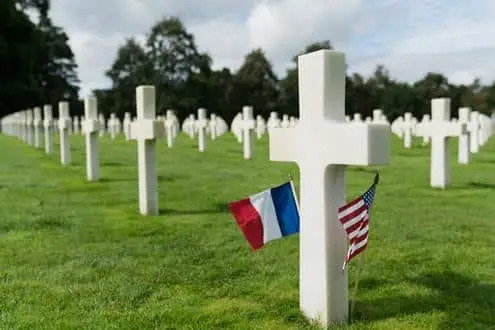
We offer many ways to visit Normandy from Paris
- American Normandy D-Day Tour from Paris
- Caen Normandy Tours
- D-Day Tour with Overnight in Bayeux and Mont St. Michel
- Custom and Private Normandy D-Day Tours
- Mont Saint Michel day trip
- Our complete list of Normandy Tours
Caen War Memorial: The Caen Memorial offers visitors a journey through the mid-20th century from the second World War through the Cold War era. Exhibits offer thoughtful commentary about peace and the future of war. The museum is a good starting point for Normandy D-Day touring, reminding the visitor of the complicated and extensive political origins of the second World War.
Towns in Normandy
Giverny: During a fateful train ride to western France, Claude Monet spotted this small village along the Seine, about 50 miles from Paris, and vowed to live there. By 1890 he had bought the land and home that he memorialized in so many of his paintings. Particularly in his magnificent water lily series. Today, art lovers take the train to Vernon and a short bus ride to see the house and gardens which are open from April to October. Also locally, visitors can see the colony of houses that were once occupied by American Impressionist painters in the mid 19th century and an excellent local museum featuring rare impressionist works.
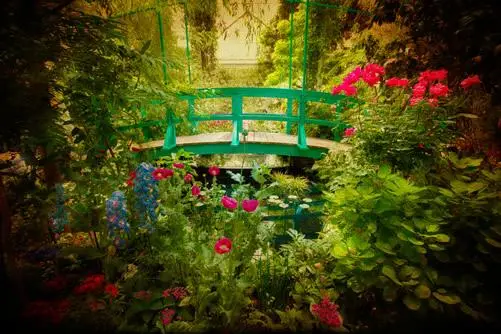
Rouen – Get to know the historic city of Joan of Arc
The city of Rouen offers visitors a rich architectural heritage accessible to all in a city where the center is almost completely pedestrianized. Wander through medieval streets amidst half-timbered houses and buildings, the oldest of which date from the 13th century, or visit one of Rouen’s many architectural jewels.
Excellent examples of the Gothic style include cathedrale Notre Dame de Rouen, the abbey church of Saint-Ouen, Saint Maclou church and the Normandy parliament building while the Gros Horloge; the Aître St Maclou or the Hotel de Bourgthéroulde are amongst the finest examples of renaissance buildings in Europe. Apart from the splendor of its architecture, the city is renown for many famous historic, literary and artistic characters, including Richard the Lionhearted, Joan of Arc, Pierre Corneille, Gustave Flaubert, Guy de Maupassant and, of course, Claude Monet.
A quick video tour of Rouen:
Rouen is truly a museum city. The fine arts museum is home to the second most important collection of Impressionist works in France while the Ceramics Museum or the Secq de Tournelles metalwork museum both offer unique collections unrivaled anywhere in the world. The Natural History Museum and the Museum Gros Horloge have both recently been entirely renovated; their creative exhibitions are delightful.
There is so much to see in Rouen! Dominating the city to the east is Mont St. Catherine. Climb to the viewpoint at the top and take in the spectacular view of the city and the river Seine as it winds its way through the dense green of the surrounding hills. A stroll along the rue de l’Eau de Robec will take the visitor back in time to the city’s industrial past. The remaining water mills testify to past glories when cloth manufacturing made the city one of the wealthiest in France. Even today, the city symbol is a sheep, a reminder that Rouen owed her opulence to the wool en and textile industries.
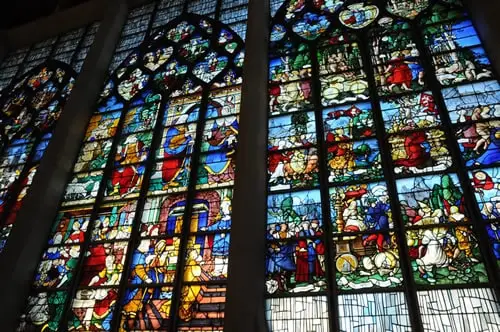
A short walk along the Seine waterfront takes the visitor into the heart of the thriving river port – the largest and most important of its kind in France. At the eastern end of the city stands the imposing new Gustave Flaubert Bridge. The city is host to a whole variety of events and lively entertainment; summer nights here are dominated by the Son et Lumière show which transforms the cathedral porch into a living canvass inspired by the works of Claude Monet. A truly awesome spectacle!
The town has 3,700 hotel rooms and more than 150 restaurants and 3,000 shops to welcome you. Rouen offers the visitor a gourmet destination with fabulous shopping opportunities. Fiercely proud of her history and heritage, yet ready to face and to lead the way into this new century, Rouen has so much to offer, We hope that the following pages will give you a sense of the warmth of the welcome that awaits you in this most lovely city in the heart of historic Normandy.
Visit the Rouen Tourist Office website for more information or contact us to create a special vacation to Normandy.
Bayeux Tapestry: The Tapisserie de Bayeux (Bayeux Tapestry) is a world-famous Medieval masterpiece that dates back to 1060 a.d. The tapestry depicts the epic story of William the Conqueror’s conquest of England.
The small towns of Dieppe, Fecamp, and /Etretat: Dieppe is the oldest seaside resort in France. Its history is retold in the local castle museum. The Benedictine Palace & Museum, home of the famous Benedictine liqueur, is Fécamp’s main claim to fame. Also, don’t miss the towns picturesque marina. A short drive down the coast lies the village of Etretat, nestled between beautiful striking white cliffs.
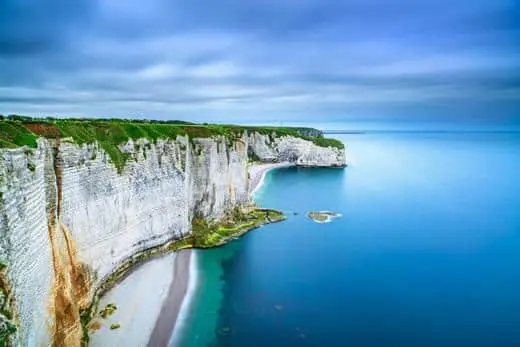
Deauville, Honfleur, and Trouville: Driving along the “Flowered Coast” of Normandy, three picture perfect towns stand out: the glamorous resort town of Deauville, home to the rich and famous (and a noted film festival), its twin city of Trouville, and the harbor town of Honfleur.
Deauville is a thriving vacation spot of luxury hotels, casinos, race tracks, golf courses and polo grounds. Its twin city, Trouville, separated from Deauville by the Touques river, is a more sedate fishing village. Both towns boast wide sandy beaches.
Further along the coast you’ll find Honfleur, considered the birthplace of impressionist painting. This charming harbor village, with narrow timbered houses dates from the 11th century, and has attracted many artists, among them Monet and the poet Baudelaire.
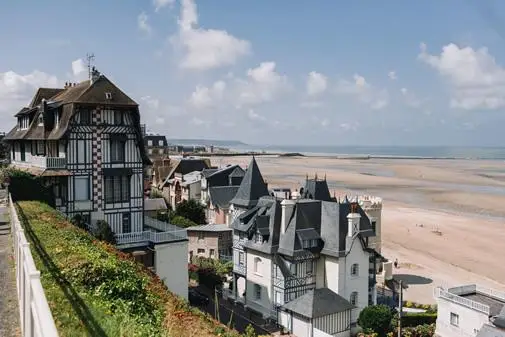
Alencon, Haras du Pin, and Bagnole de L’Orne: A discovery of the region would be incomplete without a mention of the region’s passion for horse breeding. Tourists are welcome to attend any of the numerous horse shows and competitions and visit the many horse breeding estates, of which the Haras du Pin, or the “Versailles of horses”, is the most exceptional. Alencon’s Fine Arts and Lace Museum presents a major collection of French and European lace from the 17th through the 20th century. The nearby town of Bagnoles de l’Orne is a world class premier spa center.
Mont Saint Michel: The enchanting abbey of Mont St. Michel is perched precariously on a 264-foot high rocky islet connected to mainland France by a causeway. Surrounded by over half a mile of massive walls and reached by a steep climb up winding streets, it remains one of the greatest sightseeing attractions in the world and is the second most visited place in France after the Eiffel Tower. Mont St. Michel is also known for its dramatic tides, the highest on the continent, which race towards the isle at the speed of “galloping horses”. Visit Mont St. Michel with a one day trip from Paris.
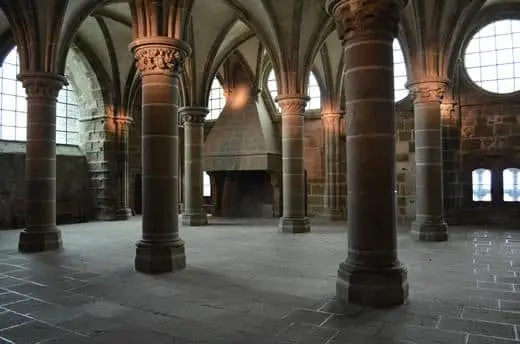
Getting to Normandy from Paris
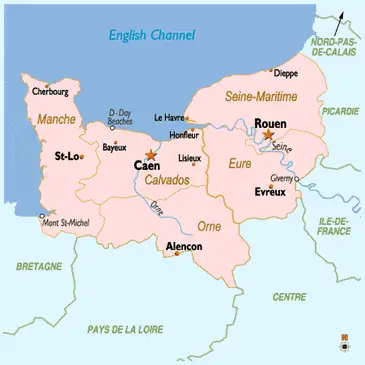
Where is Normandy? For reference the landing beaches are located about 155 miles west of Paris.
By train:
Direct connections from Paris to all of the main cities in Normandy. From St Lazare train station there are direct trains to Rouen, Le Havre, Caen, Deauville and Cherbourg. Trains run from the Montparnasse train station to Alençon and Mont Saint Michel (with connection).
By air:
From London, flights to Caen (Brit’Air, Flandre Air), Rouen (Flandre Air.Regional Airlines), Le Havre (Regional Airlines, Flandre Air, Brit’Air) and Deauville (BritAir).
By boat:
From England, direct connections to Caen and Ouistreham (Brittany Ferries), Cherbourg (P&O European Ferries, Brittany Ferries), and Le Havre (P&O European Ferries).
By car:
Roissy CDG airport is only 2 hours drive from Normandy
Gastronomy
Tarte tatin, anyone? The incredible slow-cooked apple dessert served all over France is from Normandy, home of centuries-old apple orchards. Talk about heirloom fruit. Likewise the Normande cattle, said to be descended from Viking cows brought over in the 9th century. The high fat milk means the prized butter is sought-after in Paris by chefs and diners alike. The marbled meat is gamey and delicious. Cheeses like Camembert, Livarot, and Pont l’Eveque are local, and for some an acquired, pungent, taste.
With a 300 mile coastline, Normandy seafood is a natural, especially oysters. A typical 2 or 3 course prix fixe lunch generally offers a first course of a half dozen oysters. At 12 to 15 euros for the whole meal, Normandy lunches are quite the deal.
Inland, salt grass sheep are raised for their distinctively-flavored flesh; picturesque flocks are viewed for miles as you drive toward Mont St. Michel and the marsh lands surrounding the monastery. Unlike just about anywhere else in France, Normandy does not grow grapes. It’s just too cold. Bu the apple orchards yield a different prize: Calvados, or what we Americans call apple jack or apple brandy. Hard cider is also local. Many an enthusiastic visitor has tried some of the refreshing coif and found themselves in a pleasant afternoon nap from the delicious high alcohol “juice.”
Michelin-starred restaurants can be found in Caen, Deauville, Honfleur and even the tiny medieval canal town of Bayeux. The famous film festival at Deauville and the fancy race horse business brings jet setters with a refined appetite, but chefs gravitate to the wonderful local ingredients and culinary lifestyle which is less Paris, more earthy.
Speaking of Paris, the next time you order an oyster opener, a steak with frites, a Camembert cheese course and a tarte tatin to finish, you now know you ate a typical Normandy meal, with ingredients from the rolling green hills and rocky, dramatic coast northwest of Paris.
Sports and Leisure in Normandy
Sea and river pleasures: The region is known as a port of call for many cruise lines. Stops at Le Havre are very common. From Le Havre, trips to the D-Day landing beaches, Mont St. Michel, or even Paris are possible (contact us for more details).
River cruises and fishing excursions are also available throughout the region. Sailing and windsurfing are also available at Deauville, Trouville, Fécamp and Granville among others.
Biking, Hiking and the great outdoors: Cycling is popular in Normandy especially along the coast, which is not too hilly; in the Cotentin Peninsula, with little traffic; in the rolling hills of Suisse Normande dotted with villages and picnic spots; or the Seine Valley. The Suisse Normande is also a great area for canoeing, rock climbing, and hiking.
Hikers will love the Parc Regional de Normandie-Maine, Parc Regional de Brotonne, Parc Regional du Perche, or the Parc des Marais du Cotentin etdu Bessin. Normandy has ten long-distance walking itineraries and 7500 km of paths with signposts as well as lots of footpaths for shorter walks.
Horseback riding is available throughout the region. Rural trails will delight and relax the avid and novice rider alike. Or, take in the horse races at the prestigious Deauville racetrack. Le Pin national Stud at Haras du Pin is also worth a visit.
Golf: There are 37 golf courses in the region, of which 25 have 18-hole courses, including a scenic course atop a cliff near Etretat. The resort town of Deauville has four individual courses. At Le Vaudreuil, set in a park between two branches of the river Eure sits one of France’s most beautiful golf courses. Other sites include the Château du Champs de Bataille and Bellême.
Learn about all of our Normandy tours and excursions.